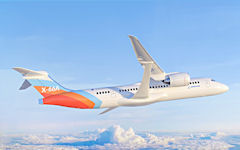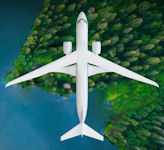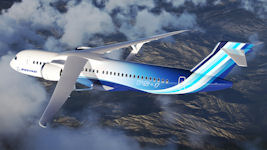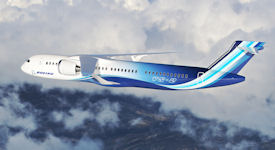X-66
NASA’s Sustainable Flight Demonstrator (SFD), a full-scale transonic truss braced wing (TTBW) design in development by Boeing for flight tests later this decade, was designated the X-66A by the U.S. Air Force 12 June 2023. The latest X-plane, the X-66A is the first in the almost 80-year experimental aircraft series specifically focused on achieving the goal of net-zero aviation greenhouse gas emissions, according to NASA.
The X-66A is a heavily modified Douglas MD-90 that was once operated by Delta Air Lines. While the new design retains the cockpit and T-tail, its brand-new wings feature a high aspect ratio and are extremely long and thin, which leads to less resistance. Its wingspan is 44 meters, which is around 50 percent longer than that of a conventional commercial aircraft of similar size. To make this form structurally sound, trusses anchored in the fuselage run to the middle underside of each wing to provide lift. Since the aircraft straddles the sound barrier at transonic speeds of between Mach 0.8 and 1.2, the concept is called Transonic Truss-Based Wing (TTBW). The wing design alone is expected to shave 10 percent off fuel consumption. In combination with other aerodynamic improvements and new engine concepts, this means that the X-66A could prove up to 30 percent more efficient than today’s conventional jets.
The new X-plane seeks to inform a potential new generation of more sustainable single-aisle aircraft – the workhorse of passenger airlines around the world. Working with NASA, Boeing will build, test, and fly a full-scale demonstrator aircraft with extra-long, thin wings stabilized by diagonal struts, known as a Transonic Truss-Braced Wing concept. Key modifications by Boeing to the MD-90 will include replacing its wings with a new pair that will be thinner and extra-long, stabilized by diagonal struts. The design concept, known as the Transonic Truss-Braced Wing configuration, promises to be more fuel efficient than today’s best-in-class commercial aircraft.
NASA announced 18 January 2023 it had issued an award to The Boeing Company for the agency’s Sustainable Flight Demonstrator project, which seeks to inform a potential new generation of green single-aisle airliners. Under a Funded Space Act Agreement, Boeing will work with NASA to build, test, and fly a full-scale demonstrator aircraft and validate technologies aimed at lowering emissions. Over seven years, NASA will invest $425 million, while the company and its partners will contribute the remainder of the agreement funding, estimated at about $725 million. As part of the agreement, the agency also will contribute technical expertise and facilities.
“Since the beginning, NASA has been with you when you fly. NASA has dared to go farther, faster, higher. And in doing so, NASA has made aviation more sustainable and dependable. It is in our DNA,” said NASA Administrator Bill Nelson. “It’s our goal that NASA’s partnership with Boeing to produce and test a full-scale demonstrator will help lead to future commercial airliners that are more fuel efficient, with benefits to the environment, the commercial aviation industry, and to passengers worldwide. If we are successful, we may see these technologies in planes that the public takes to the skies in the 2030s.”
“At NASA, our eyes are not just focused on stars but also fixated on the sky. The Sustainable Flight Demonstrator builds on NASA’s world-leading efforts in aeronautics as well climate,” said NASA Administrator Bill Nelson. “The X-66A will help shape the future of aviation, a new era where aircraft are greener, cleaner, and quieter, and create new possibilities for the flying public and American industry alike.”
The X-66A is the first X-plane specifically focused on helping the United States achieve the goal of net-zero aviation greenhouse gas emissions, which was articulated in the White House’s U.S. Aviation Climate Action Plan.
“To reach our goal of net zero aviation emissions by 2050, we need transformative aircraft concepts like the ones we’re flying on the X-66A,” said Bob Pearce, associate administrator for NASA’s Aeronautics Research Mission Directorate, who announced the designation at the American Institute of Aeronautics and Astronautics Aviation Forum in San Diego. “With this experimental aircraft, we’re aiming high to demonstrate the kinds of energy-saving, emissions-reducing technologies the aviation industry needs.”
NASA and Boeing sought the X-plane designation shortly after the agency announced the Sustainable Flight Demonstrator project award earlier this year. The Air Force confers X-plane status for development programs that set out to create revolutionary experimental aircraft configurations. The designation is for research aircraft. With few exceptions, X-planes are intended to test designs and technologies that can be adopted into other aircraft designs, not serve as prototypes for full production.
“We’re incredibly proud of this designation, because it means that the X-66A will be the next in a long line of experimental aircraft used to validate breakthrough designs that have transformed aviation,” said Todd Citron, Boeing chief technology officer. “With the learnings gained from design, construction, and flight-testing, we’ll have an opportunity to shape the future of flight and contribute to the decarbonization of aerospace.”
For the X-66A, the Air Force provided the designation for an aircraft that validates technologies for a Transonic Truss-Braced Wing configuration that, when combined with other advancements in propulsion systems, materials, and systems architecture, could result in up to 30% less fuel consumption and reduced emissions when compared with today’s best-in-class aircraft.
Due to their heavy usage, single-aisle aircraft today account for nearly half of worldwide aviation emissions. Creating designs and technologies for a more sustainable version of this type of aircraft has the potential for profound impact on emissions.
NASA’s history with the X-plane designation dates to the 1940s, when its predecessor agency, the National Advisory Committee for Aeronautics (NACA) jointly created an experimental aircraft program with the Air Force and the U.S. Navy. The X-66A is the latest in a long line of NASA X-planes. Additionally, NASA’s Armstrong Flight Research Center in Edwards, California, has provided technical expertise and support for several additional X-planes.
For the Sustainable Flight Demonstrator, NASA had a Funded Space Act Agreement with Boeing through which the agency will invest $425 million over seven years, while the company and its partners will contribute the remainder of the funding, estimated at about $725 million. NASA also will contribute technical expertise and facilities.
The Sustainable Flight Demonstrator project is an activity under NASA’s Integrated Aviation Systems Program and a key element of the agency’s Sustainable Flight National Partnership, which focuses on developing new sustainable aviation technologies.
The Transonic Truss-Braced Wing concept involves an aircraft with extra-long, thin wings stabilized by diagonal struts. This design results in an aircraft that is much more fuel efficient than a traditional airliner due to a shape that would create less drag – resulting in its burning less fuel.
“NASA is working toward an ambitious goal of developing game-changing technologies to reduce aviation energy use and emissions over the coming decades toward an aviation community goal of net-zero carbon emissions by 2050,” said Bob Pearce, NASA associate administrator for the Aeronautics Research Mission Directorate. “The Transonic Truss-Braced Wing is the kind of transformative concept and investment we will need to meet those challenges and, critically, the technologies demonstrated in this project have a clear and viable path to informing the next generation of single-aisle aircraft, benefiting everyone that uses the air transportation system.”
NASA’s goal is that the technology flown on the demonstrator aircraft, when combined with other advancements in propulsion systems, materials, and systems architecture, would result in fuel consumption and emissions reductions of up to 30% relative to today’s most efficient single-aisle aircraft, depending on the mission. Through separate efforts, NASA has worked with Boeing and other industry partners on advanced sustainable aviation concepts, including the Transonic Truss-Braced Wing concept.
“We’re honored to continue our partnership with NASA and to demonstrate technology that significantly improves aerodynamic efficiency resulting in substantially lower fuel burn and emissions,” said Todd Citron, Boeing chief technology officer. “Boeing has been advancing a multipronged sustainability strategy, including fleet renewal, operational efficiency, renewable energy, and advanced technologies to support the U.S. Aviation Climate Action Plan and meet the industry objective of net zero carbon emissions by 2050. The Sustainable Flight Demonstrator builds on more than a decade of NASA, Boeing, and our industry partners’ investments to help achieve these objectives.”
The new Funded Space Act agreement allows NASA to capitalize on private industry knowledge and experience, with Boeing and its partners laying out a proposed technical plan. NASA will provide access to its aeronautics facilities and expertise. NASA will not procure an aircraft or any other hardware for its missions. The agency will obtain access to certain ground and flight data that can be used to validate the airframe configuration and associated technologies.
The Sustainable Flight Demonstrator will help the United States achieve net-zero carbon emissions from aviation by 2050 – one of the environmental goals articulated in the White House’s U.S. Aviation Climate Action Plan. The International Civil Aviation Organization also has set a goal of net-zero carbon emissions by 2050.
|
NEWSLETTER
|
| Join the GlobalSecurity.org mailing list |
|
|
|






